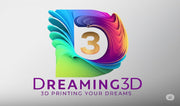News
Dreaming3D: Your Partner for 3D Innovation in San Diego
Dreaming3D is a San Diego–based 3D printing and additive manufacturing company that brings ideas to life. Founded in Nashville and now headquartered in San Diego, Dreaming3D offers a full suite of services – from 3D printing and 3D printer repair to custom computer building – all designed to help businesses and creators produce almost anything on demand. Using eco‑friendly PLA filament made from corn‑starch, Dreaming3D can print gadgets, tools, prototypes, gaming equipment, collectibles and more. In fact, “with your imagination, the sky is [the] limit,” as Dreaming3D’s website emphasizes. Every product and custom computer is built in San Diego and ships...
Affordable 12‑Color Multicolor 3D Printer Hits Kickstarter Goal in Two Minutes
A new 3D printer from Yumi’s C‑series has made waves on Kickstarter, reaching its funding goal in just two minutes. Marketed as the “fastest multicolor printer in the galaxy,” the C-series impresses with support for up to 12 different filament colors in a single print .
The campaign launched July 2025 with two tiered models priced at around $195 (expected MSRP ~$299). The speedy funding response highlights the printer’s appeal within the enthusiastic maker and hobbyist community .
Yumi claims the C-series boasts rapid color transitions thanks to multiple color inputs feeding into one nozzle—minimizing retraction time and maximizing...
How 3D Printing Is Tackling Global Challenges
Additive manufacturing, or 3D printing, is rapidly maturing from a niche prototyping tool into a versatile force for change. By building objects layer by layer from digital designs, 3D printing can make products on demand—often with less waste and lower energy use than traditional methods. Today this technology is being applied to some of humanity’s biggest problems. From recycling and sustainability to healthcare, affordable housing, space exploration, and supply chain resilience, real-world projects show 3D printing’s optimistic potential. In the sections below we explore five key areas where 3D printing is making a positive impact, with concrete examples and innovations.
Sustainability:...
Resin vs FDM 3D Printing: A Deep Dive on Cost, Quality, Speed, and Safety
3D printing comes in many forms, but two dominant desktop technologies are Fused Deposition Modeling (FDM) and resin-based printing (SLA/DLP). FDM printers extrude molten filament (e.g. PLA, PETG, ABS) in layers, while resin printers cure liquid photopolymers with UV light. Each approach has unique advantages and trade‐offs. In general, resin printers deliver much finer detail and smoother surfaces, whereas FDM machines are simpler, use cheaper materials, and can produce larger, more functional parts4dfiltration.comformlabs.com. This comparison examines both technologies in depth – covering costs, print quality, speed, and safety – and then explores key use cases (miniatures, prototyping, dental models, and manufacturing) where one...
3D Printing and the Environment: Weighing the Positives and Negatives
As 3D printing (additive manufacturing) continues to reshape industries from automotive to healthcare, it brings with it both exciting environmental opportunities and complex sustainability challenges. While the technology is often lauded for reducing waste and decentralizing production, it also raises concerns related to energy consumption, material sourcing, and microplastic pollution.
This blog explores the environmental positives and negatives of 3D printing to help professionals, policymakers, and makers alike better understand its overall ecological footprint.
🌱
Positive Environmental Impacts of 3D Printing
1. Material Efficiency and Waste Reduction
Traditional manufacturing often involves subtractive processes—cutting away large portions of raw...





